1908-1980
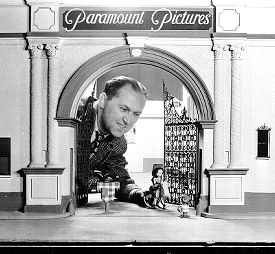
George Pal on a Puppetoon set, 1940's
"He
was a wonderfully kind man. I was only a novice when I did The Time Machine
and George went out of his way to make me feel comfortable and explain
things to me. He treated all of us like human beings -- not like cattle."
- Yvette Mimieux
"He
was the Walt Disney of science-fiction films."
- Forrest J. Ackerman
"Enthusiastic
isn't the word to describe him. If there's a word surpassing 'enthusiastic,'
that is it. Any film that he became first-hand involved with received
all his heart and passion and love; every project was just that -- a labor
of love."
- Gae Griffith

From
Gail Morgan Hickman's The Films of George Pal
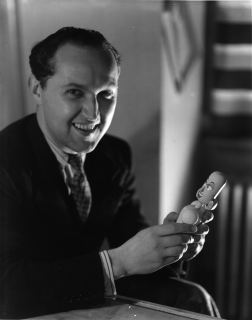 [The
best book on George Pal, and the one that has sustained his fans for many
years is Gail Morgan Hickman's The Films Of George Pal, published
by A. S. Barnes and Company in 1977. Hickman, like so many of the people
you'll meet in these pages, saw "The Time Machine" at a young
age and became an avid fan of Pal and his films. Hickman's book is rare
today and commands a substantial price... often from $150 to $210... if
you can find a copy!]
[The
best book on George Pal, and the one that has sustained his fans for many
years is Gail Morgan Hickman's The Films Of George Pal, published
by A. S. Barnes and Company in 1977. Hickman, like so many of the people
you'll meet in these pages, saw "The Time Machine" at a young
age and became an avid fan of Pal and his films. Hickman's book is rare
today and commands a substantial price... often from $150 to $210... if
you can find a copy!]
George Pal, Jr. was born in
Cegled, Hungary, in a small town about forty miles from Budapest, on February
1, 1908, the son of Maria and George Pal. Young George came from a theatrical
family. His grandfather and grandmother had been members of the National
Theatre, and his mother and father were entertainers in a traveling theatre.
Because his parents were on the road so much, Pal was raised by his grandparents.
Young Pal was not interested
in the theatre, but decided instead to attend the Budapest Academy of
Arts in order to study architecture. Times were hard, and Pal's family
was poor. In order to put himself through school, he did all kinds of
odd jobs for money.
A medical school just down
the street offered classes in anatomy to its students. Pal found that
by simply slipping on a white smock, he could sneak into the classes and
learn anatomy. "The doctors," he says, "had to learn how
to draw muscles and bones -- no matter how badly -- so that they knew
them. I drew pretty good. So I reproduced my drawings and sold them to
the medical students. I had to make money somehow. I think the medical
professor got suspicious because so many students turned in similar drawings.
But he let it pass."
Architectural students in
Hungary must spend one year as either a carpenter or bricklayer, and Pal
decided to work as a carpenter. In fact he enjoyed the work so much, he
decided to spend a second year on the job and become a licensed carpenter.
He says: "I think working with wood helped me an awful lot with the
Puppetoons later on. I think without that experience I would probably
never have invented the Puppetoon system.
[Pal worked
for the UFA studios in Germany in the early '30's, leaving when the Nazis
took power. He then went to Paris, where he made stop-motion animated
cartoons for Philips Radio of Holland. The company invited Pal to come
to Holland and set up shop there. Pal made advertising films in Holland
and built his studio, coining the word Puppetoons to incorporate his style
of stop-motion animation. Pal applied for a visa to the US, and in 1939,
came to New York, where he was a guest lecturer at Columbia University.
Paramount signed him up, and he moved to California and opened a small
studio where he began making Puppetoons for the studio. He won a special
Academy Award in 1943, and in 1949 produced his first feature, "The
Great Rupert," which incorporated Puppetoon techniques, as did many
of his later films, including "The Time Machine." "Destination
Moon" followed "Rupert" in 1950; "When Worlds Collide"
was released in '51; and with the classic "War of the Worlds"
in '53, Pal's reputation as a master of movie science-fiction was
firmly established.]
A
Sequel to "The Time Machine?"
"I
never give up, let go, you know?"
Pal's office on the Paramount
lot in 1977 was described by author Ed Naha as "... a typical Paramount
cubicle, directly across the hall from another SF luminary, Gene Roddenberry."
in Starlog, Naha wrote of Pal's determination to make a Time Machine
sequel, something Pal longed to do... but never got the opportunity.
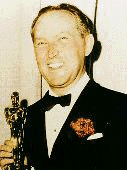 All
of Pal's films have been well received. The
War of the Worlds won an Academy Award for special effects, as
did Destination
Moon and Tom
Thumb. Nowadays, however, it is The
Time Machine that's the apple of Pal's eye. "Joe Morehaim
and I are presently writing a new Time Machine movie," he
says proudly. "Simultaneously, we are writing a novel of it, called
The Return of the
Time Machine. It will be a full-sized novel and we hope it is
a big hit."
All
of Pal's films have been well received. The
War of the Worlds won an Academy Award for special effects, as
did Destination
Moon and Tom
Thumb. Nowadays, however, it is The
Time Machine that's the apple of Pal's eye. "Joe Morehaim
and I are presently writing a new Time Machine movie," he
says proudly. "Simultaneously, we are writing a novel of it, called
The Return of the
Time Machine. It will be a full-sized novel and we hope it is
a big hit."
Pal is planning big things
for his continuation of the classic H. G. Wells tale. "This is actually
how the film will begin," he says, relishing every moment of his
storytelling. "We open it up with The Time Traveler and Weena rushing
back from the future. They're both in The Time Machine. Weena is
pregnant and The Time Traveler wants his son to be born in his own time
period. He's a Victorian, you know, so it has to be a son. He's
very determined about that. He wants his son to be born in his own time,
and his own place. He drives so recklessly and so fast that the machine
hits the wrong moment and place and freezes during the London Blitz of
1943. It cracks, you know? Tumbles and cracks. Weena runs out into the
street in panic. He runs after her to try to protect her from the
bombing with his own body. He gets killed and, then, she gets killed.
The planes leave. And there's a long, long silence. Suddenly, we hear
a baby cry. Then we pan over to the Time Machine and, next to it, is a
1977 version of the machine. A brand-new one. A young man stands there
who looks like both The Time Traveler and Weena. He has just witnessed
the death of his parents and his own birth. That's the way we start! From
then on in, it's the story of the young man trying to find his parents
in the future and warn them not to try to go back in time. Because if
they do, they'll be killed. He would rather not be born than to have his
parents die. Isn't that a great idea?" he asks gleefully.
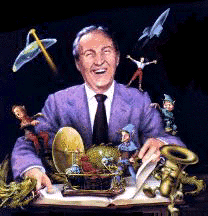 George
Pal is a man in love with his art. He's an avowed optimist. But, he's
also a realist... especially when it comes to his filmmaking. "I'm
like a Bulldog," he says. "I never give up, let go, you know?"
Pal's determination on The Time Machine sequel has lasted 17 years! The
original film was released in 1960. "It's taken us so many years
to do this sequel for many reasons," he says matter-of-factly, "the
idea wasn't received very well originally. We had to develop it further.
The original was so successful, it seems odd that no one would want an
immediate sequel. But that's how this business is, eh? They don't realize
how many people want movies like this. There's a ready-made audience out
there. They just never seem to understand. I don't even know how Star
Wars was born, you know. It is all so difficult to start a film like
that."
George
Pal is a man in love with his art. He's an avowed optimist. But, he's
also a realist... especially when it comes to his filmmaking. "I'm
like a Bulldog," he says. "I never give up, let go, you know?"
Pal's determination on The Time Machine sequel has lasted 17 years! The
original film was released in 1960. "It's taken us so many years
to do this sequel for many reasons," he says matter-of-factly, "the
idea wasn't received very well originally. We had to develop it further.
The original was so successful, it seems odd that no one would want an
immediate sequel. But that's how this business is, eh? They don't realize
how many people want movies like this. There's a ready-made audience out
there. They just never seem to understand. I don't even know how Star
Wars was born, you know. It is all so difficult to start a film like
that."

Another
Unfulfilled Dream
 The
new book "The
Fifty Greatest Movies Never Made" by Chris Gore features a short
segment on another Pal project that never reached the screen: "The
Disappearance."
The
new book "The
Fifty Greatest Movies Never Made" by Chris Gore features a short
segment on another Pal project that never reached the screen: "The
Disappearance."
"A man like George Pal, who wrote, directed, produced, and even
photographed films, had to be something of a sophisticated thinker,"
writes Gore, "and at some point, he decided he'd like to get his
more sophisticated thoughts captured on film. 'The Disappearance' could
have been his vehicle."
 "The
basic premise of 'The Disappearance,'" according to Gore, "is
that one day all women disappear from the earth. The men are all alone,
except for the fact that women are really still around; they've just been
caught in some kind of dimensional shift. From their perspective, it's
the men who have vanished. Both men and women, seemingly without counterpart
in the world they had known together, proceed to experience what the world
would be if they were alone."
"The
basic premise of 'The Disappearance,'" according to Gore, "is
that one day all women disappear from the earth. The men are all alone,
except for the fact that women are really still around; they've just been
caught in some kind of dimensional shift. From their perspective, it's
the men who have vanished. Both men and women, seemingly without counterpart
in the world they had known together, proceed to experience what the world
would be if they were alone."
The playing out of this scenario - by today's standards - is pretty stereotypical:
in the men's world, WW III erupts; in the women's world, planes crash
and equipment hopelessly beyond the ken of women is left "unattended."
Gore states that Pal optioned the Philip
Wylie novel in 1951, but that Paramount was put off by sexual elements
in the novel (the 'male' world remains distinctly heterosexual - but not
so the 'women's' world!) Pal reacquired the rights after he moved to MGM,
which announced the project in 1965, but never officially put the film
into production. According to Gore, "Pal was still actively planning
the film [when]... he died on May 2, 1980, while his movie 'The Voyage
of the Berg' was in production. ('The Voyage of the Berg' also "remains
unfinished and unreleased," according to Gore.)

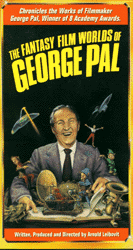
You can buy Arnold Leibovit's excellent documentary -
and read more about George Pal - at The
Sci-Fi Station.
Don Brockway, April 22, 2000 (updated October 12, 2004)
